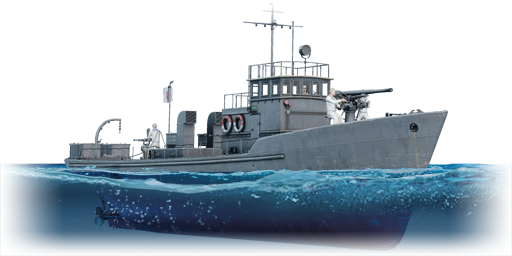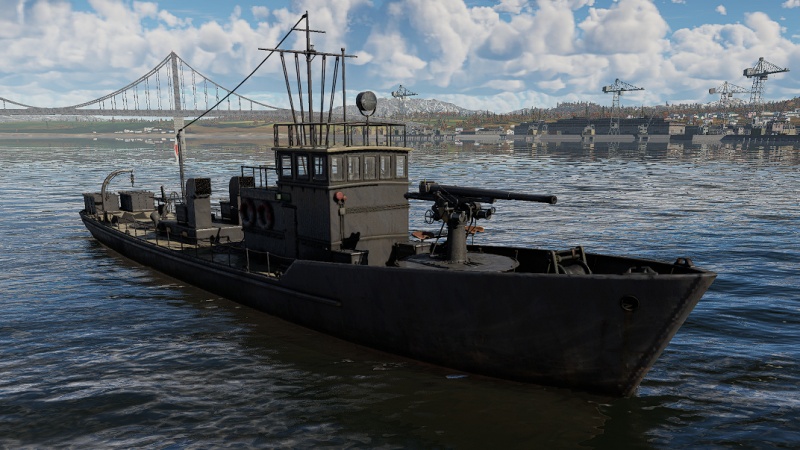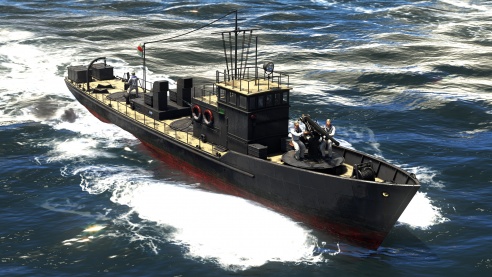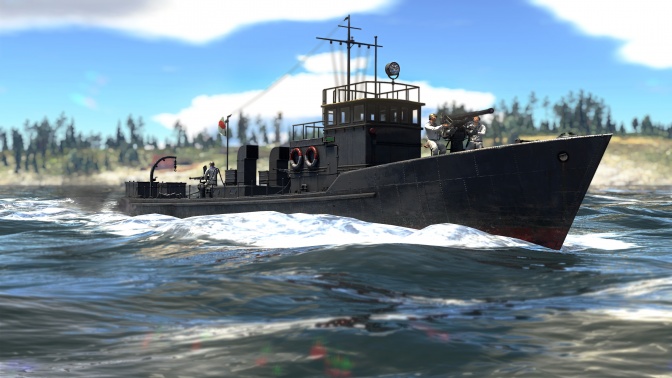Difference between revisions of "Type 5"
(→Armament) |
(→Pros and cons: I have noticed that quite a lot, being a coastal player myself) (Tag: Visual edit) |
||
| (One intermediate revision by one other user not shown) | |||
| Line 47: | Line 47: | ||
{{:Type 88 AA (75 mm)/Ammunition|75 mm type 90 HE, 75 mm type 95 AP, 75 mm type 90 HE-TF}} | {{:Type 88 AA (75 mm)/Ammunition|75 mm type 90 HE, 75 mm type 95 AP, 75 mm type 90 HE-TF}} | ||
| + | |||
=== Secondary armament === | === Secondary armament === | ||
{{Specs-Fleet-Secondary}} | {{Specs-Fleet-Secondary}} | ||
| Line 54: | Line 55: | ||
The Type 5 is equipped with two 20 mm Type 98 cannon mounts for its secondary weapon.They do however have a limited firing arc and can only engage enemy vessels from the sides or rear of the boat. Despite this they are a moderately powerful weapon to fall back on, or to attack vessels approaching from behind. They work well at close range, and can function adequately up to around 1,500 m, but at this distance it will struggle to do a lot of damage. The magazine contains 20 rounds and reloads very quickly, allowing for a steady stream of fire against enemy vessels or aircraft. It comes with three belts: | The Type 5 is equipped with two 20 mm Type 98 cannon mounts for its secondary weapon.They do however have a limited firing arc and can only engage enemy vessels from the sides or rear of the boat. Despite this they are a moderately powerful weapon to fall back on, or to attack vessels approaching from behind. They work well at close range, and can function adequately up to around 1,500 m, but at this distance it will struggle to do a lot of damage. The magazine contains 20 rounds and reloads very quickly, allowing for a steady stream of fire against enemy vessels or aircraft. It comes with three belts: | ||
| − | * Universal - | + | * '''Universal:''' {{Annotation|HEF-T|High-explosive fragmentation tracer}}{{-}}{{Annotation|AP-T|Armour-piercing tracer}}{{-}}{{Annotation|HEF-T|High-explosive fragmentation tracer}}{{-}}{{Annotation|AP-T|Armour-piercing tracer}} |
| − | * HET - | + | * '''HET:''' {{Annotation|HEF-T|High-explosive fragmentation tracer}}{{-}}{{Annotation|HEF-T|High-explosive fragmentation tracer}}{{-}}{{Annotation|HEF-T|High-explosive fragmentation tracer}}{{-}}{{Annotation|AP-T|Armour-piercing tracer}} |
| − | * APT - | + | * '''APT:''' {{Annotation|AP-T|Armour-piercing tracer}}{{-}}{{Annotation|AP-T|Armour-piercing tracer}}{{-}}{{Annotation|AP-T|Armour-piercing tracer}}{{-}}{{Annotation|HEF-T|High-explosive fragmentation tracer}} |
Overall, the HET type rounds do the most damage consistently to most of the vessels you'll be coming across, so it's best to take a lot of HET belts, though also consider bringing some armour piercing belts in case you come across some more heavily armoured boats in the deadzone of your main cannon. All in all though these 20 mm cannons will be most useful against enemy aircraft, as although the main cannon has a timed fuse shell, it's better to keep it focused on enemy boats and let the 20 mm cannons tackle aircraft. | Overall, the HET type rounds do the most damage consistently to most of the vessels you'll be coming across, so it's best to take a lot of HET belts, though also consider bringing some armour piercing belts in case you come across some more heavily armoured boats in the deadzone of your main cannon. All in all though these 20 mm cannons will be most useful against enemy aircraft, as although the main cannon has a timed fuse shell, it's better to keep it focused on enemy boats and let the 20 mm cannons tackle aircraft. | ||
| − | {{:Type 98 (20 mm)/Ammunition| | + | {{:Type 98 (20 mm)/Ammunition|HEF-T, AP-T}} |
| + | |||
=== Additional armament === | === Additional armament === | ||
{{Specs-Fleet-Additional}} | {{Specs-Fleet-Additional}} | ||
| Line 86: | Line 88: | ||
* Powerful main cannon, can sink most boats in a few hits | * Powerful main cannon, can sink most boats in a few hits | ||
* Versatile secondary armament | * Versatile secondary armament | ||
| + | * Can soak up quite a lot of damage, especially in downtiers | ||
'''Cons:''' | '''Cons:''' | ||
| Line 108: | Line 111: | ||
;Skins | ;Skins | ||
| + | |||
* [https://live.warthunder.com/feed/camouflages/?vehicle=jp_type5_escortboat Skins and camouflages for the {{PAGENAME}} from live.warthunder.com.] | * [https://live.warthunder.com/feed/camouflages/?vehicle=jp_type5_escortboat Skins and camouflages for the {{PAGENAME}} from live.warthunder.com.] | ||
Latest revision as of 15:24, 4 March 2023
| This page is about the Japanese sub-chaser Type 5. For other uses, see Type 5 (Disambiguation). |
Contents
Description
The Type 5 is a rank I Japanese sub-chaser with a battle rating of 1.7 (AB/RB/SB). It was introduced in Update 1.89 "Imperial Navy".
General info
Survivability and armour
The Type 5 has no additional armour protection, other than the 8 mm of steel that make up the hull. It is a fairly large ship though, and in regards to survivability this is a detriment and advantage. As it's large and fairly slow, its very easy to hit accurately at close and long range, meaning it will take a large amount of fire. However, it does have four hull compartments and 21 crew members, which does make it more survivable than most of the commonly found vessels around its battle rating. Its survivability largely does depend on what its fighting though, high calibre guns and rapid fire cannons will sink it fairly quickly down to how easy it is to hit, whereas high calibre machine gun fire will take a while to cause critical damage.
Mobility
The Type 5 is fairly lacking when it comes to speed and overall mobility, it can reach a max of 23 km/h in RB modes, and 32 km/h in AB modes, making it one of the slowest vehicles around its battle rating. It's also fairly unresponsive to changes in direction, and will take a comparatively long time to turn, this can make it difficult to avoid torpedoes or to angle the on board weaponry as the primary and secondary armaments have quite significant deadzones.
Modifications and economy
Armament
Primary armament
The Type 5 is equipped with a 75 mm cannon for its main gun, and its fairly effective on all fronts, it has a high base reload, fast traverse and high damage output. It comes with three types of ammunition-
- HE - High explosive shell, high damage output but low penetration
- APHEBC - High penetration with lower damage output, useful against armoured targets
- HE-DF - HE shell with timed fuse, useful against air targets primarily
Overall the HE round does the most consistent damage against enemy vessels, a few hits will sink most of the common MTBs around this rank, and it can even knock out smaller boats with a single shot if the round strikes a torpedo. The APHE round does little structural damage and will often overpen lightly armoured boats, it is however very useful against armoured vessels, such as the Russian river boats, it will usually destroy an armoured compartment quite easily, so it is recommended to take some APHE rounds to deal with these vessels. The timed fuse HE shell does have viable use against aircraft, but in reality the main calibre gun is best used against enemy boats, as the Type 5 is equipped with a fairly effective anti-air secondary armament.
| Penetration statistics | |||||||
|---|---|---|---|---|---|---|---|
| Ammunition | Type of warhead |
Penetration @ 0° Angle of Attack (mm) | |||||
| 100 m | 1,000 m | 2,000 m | 3,000 m | 4,000 m | 5,000 m | ||
| Type 90 HE | HE | 7 | 7 | 7 | 7 | 7 | 7 |
| Type 95 AP | APHEBC | 100 | 83 | 68 | 55 | 45 | 37 |
| Type 90 HE-TF | HE-TF | 7 | 7 | 7 | 7 | 7 | 7 |
| Shell details | ||||||||||||
|---|---|---|---|---|---|---|---|---|---|---|---|---|
| Ammunition | Type of warhead |
Velocity (m/s) |
Projectile mass (kg) |
Fuse delay (m) |
Fuse sensitivity (mm) |
Explosive mass (TNT equivalent) (g) |
Ricochet | |||||
| 0% | 50% | 100% | ||||||||||
| Type 90 HE | HE | 720 | 6.52 | 0 | 0.1 | 420 | 79° | 80° | 81° | |||
| Type 95 AP | APHEBC | 720 | 6.53 | 0.15 | 0.1 | 150 | 48° | 63° | 71° | |||
| Type 90 HE-TF | HE-TF | 720 | 6.52 | 0 | 0.1 | 420 | 79° | 80° | 81° | |||
Secondary armament
The Type 5 is equipped with two 20 mm Type 98 cannon mounts for its secondary weapon.They do however have a limited firing arc and can only engage enemy vessels from the sides or rear of the boat. Despite this they are a moderately powerful weapon to fall back on, or to attack vessels approaching from behind. They work well at close range, and can function adequately up to around 1,500 m, but at this distance it will struggle to do a lot of damage. The magazine contains 20 rounds and reloads very quickly, allowing for a steady stream of fire against enemy vessels or aircraft. It comes with three belts:
- Universal: HEF-T · AP-T · HEF-T · AP-T
- HET: HEF-T · HEF-T · HEF-T · AP-T
- APT: AP-T · AP-T · AP-T · HEF-T
Overall, the HET type rounds do the most damage consistently to most of the vessels you'll be coming across, so it's best to take a lot of HET belts, though also consider bringing some armour piercing belts in case you come across some more heavily armoured boats in the deadzone of your main cannon. All in all though these 20 mm cannons will be most useful against enemy aircraft, as although the main cannon has a timed fuse shell, it's better to keep it focused on enemy boats and let the 20 mm cannons tackle aircraft.
| Penetration statistics | |||||||
|---|---|---|---|---|---|---|---|
| Ammunition | Penetration @ 0° Angle of Attack (mm) | ||||||
| 10 m | 100 m | 500 m | 1,000 m | 1,500 m | 2,000 m | ||
| HEF-T | 2 | 2 | 2 | 2 | 2 | 2 | |
| AP-T | 41 | 38 | 28 | 19 | 13 | 9 | |
| Shell details | ||||||||||||
|---|---|---|---|---|---|---|---|---|---|---|---|---|
| Ammunition | Velocity (m/s) |
Projectile mass (kg) |
Fuse delay (m) |
Fuse sensitivity (mm) |
Explosive mass (TNT equivalent) (g) |
Ricochet | ||||||
| 0% | 50% | 100% | ||||||||||
| HEF-T | 950 | 0.13 | 0 | 0.1 | 6.17 | 79° | 80° | 81° | ||||
| AP-T | 928 | 0.13 | - | - | - | 47° | 60° | 65° | ||||
Additional armament
The Type 5 can carry six Type 95 depth charges which can be dropped to maim other naval targets, they have rather limited viability though as most MTBs will be able to outrun the explosion. However they are useful in the event of being rushed by a smaller naval vessel, as if the drop is timed right the depth charges can easily take out enemies performing this manoeuvre.
Usage in battles
The Type 5 has a lot of potential to cause damage, but it can easily be overwhelmed by enemy vessels. As it's fairly large and slow it will quickly accumulate a heavy amount of fire and damage if played in a fairly open location, as such, it's a good idea to use the environment to give yourself some hard cover, use islands, shipwrecks or whatever the map presents to keep yourself safe. The Type 5 is just too slow and vulnerable to damage to be safely played out in the open. Also, try not to advance too far into the map, as the Type 5 is slow, it's practically impossible to retreat once you've advanced too far, and if caught out it won't take long to sink.
A good spot to play the Type 5 would be to poke the front of the hull with the main cannon out from behind cover, this way only one compartment is visible to be damaged, and you have the ability to fire on enemy vessels while maintaining survivability, if you do start to take fire, you can simply reverse out of sight, repair and reengage.
Another good idea is to engage enemies at a considerable range- at around 2,000 m, at this distance enemy cannon fire will cause very little damage to you, and most small projectiles will lose most of their penetration power at this distance, all the while your main cannon will still be able to maintain a high damage output at this distance, the gun will still be fairly easy to aim and thanks to the HE, the damage output will be the same across all distances, the APHE will still be able to punch through most armoured targets at further ranges as well.
A spot on the map at range that allows you to cover most of your hull from incoming fire will likely be the best place to play the Type 5, it's just too cumbersome and large to be played out in the open, brawling with contemporary boats. If you do find yourself at close range however the secondary 20 mm mounts will likely be a more functioning weapon to use, at close range the main cannon does have a fairly large deadzone towards the back of the vessel, and due to the slow speed, angling the Type 5 to maintain line of sight isn't always going to be possible, the 20 mm cannons though do have a fairly wide arc of fire, and can provide a fairly steady stream of damage to enemy vessels and can be aimed easily to destroy the components of enemy vessels at the closer ranges, if you use the main gun at close range it is possible to miss, and this can cost you vital seconds where an enemy is free to damage you, the 20 mm cannons are easily more consistent at these ranges.
Pros and cons
Pros:
- Powerful main cannon, can sink most boats in a few hits
- Versatile secondary armament
- Can soak up quite a lot of damage, especially in downtiers
Cons:
- Very slow comparatively
- No meaningful armour protection
- Large target, easy to hit at range
- Can't hit anything in wavy waters
History
The in-game Type 5 is actually a mix of two boats - Type 5 Wooden Escort Boat (Otsu), after which it inherited weapon setup and most of the design - and the Large Steel Escort Boat (Kei-Tei) after which it inherited steel hull and the 75 mm Type 88 main gun.
Type 5 Wooden Escort Boat (Otsu) (五式木製大護衛艇(乙) was a late-war design that sailed on 23 June 1945. Its primary purpose was to escort the Daihatsu-class Landing Crafts and provide direct fire support. Only a single prototype is known to be built before war's end.
The boat was 26.8 m long, displacing 60 t under a full load. It had a fully wooden hull powered by a pair of two 160 hp Hesselman engines to a maximum speed of 12.5 knots or 23 km/h (under the full load). It was armed in a single 75 mm Type 4 Anti-Aircraft gun (四式7.5cm高射砲) that was a derivative of the Army's Type 99 gun, two twin-mount 20 mm Type 98 cannons (九八式高射機関砲), two depth charge ramps with a supply of 12 charges (reserve stored under the deck) and finally: four 8cm anti-aircraft mine dischargers (八糎打上筒). Those unusual weapons worked in a similar fashion to mortars, only instead of attempting to directly hit the enemy planes they've released a series of 7 submunitions at the attitude of up to 1,000 m. Each submunition was made of a small explosive payload hanging on a wire from a parachute and slowly descending over the battlefield with a goal of the enemy plane touching the wire to initiate the explosion. They were used as an area-denial weapon and discharged in barrages, where a single mortar could fire every 3 seconds, releasing a total of 140 anti-air mines in a single minute.[1]
Large Steel Escort Boat (Kei-Tei Mod. Kō) (鋼製大護衛艇(けい艇甲型)) was an incomplete design, studied in 1945, but never built. The boat was 23 m long steel hull with a displacement of 28.9 t, powered by a pair of 130 hp diesel engines for a maximum speed of 13 knots or 24 km/h. It was armed with a single 75 mm Type 88 anti-aircraft gun, 4 anti-aircraft machine guns (type not specified) and two depth charge ramps with a supply of 12 depth charges.[2]
Media
- Skins
See also
Links to articles on the War Thunder Wiki that you think will be useful for the reader, for example:
- reference to the series of the ship;
- links to approximate analogues of other nations and research trees.
External links
References
- ↑ 整理番号10技研法第30号 5式木製大護衛艇(乙)取扱法(案) - Japan Center for Asian Historical Records
- ↑ 護衛艇 - Imperial Japanese Navy Tokusetsukansen Database
| Japan sub-chasers | |
|---|---|







